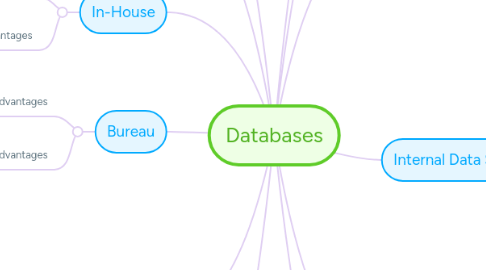
1. Database Maintenance
1.1. 1. Manage data sources
1.2. 2. Manage data entry
1.3. 3. Manage the database
1.4. 4. Manage applications
2. Issues Managing Data - Goldwag (1995)
2.1. Manage data sources - Data comes from different places and may not suit needs
2.1.1. These all need to be managed, standardised and put into a useable format
2.2. Manage data entry - Verification, validation, de-duplication, merge purge, suppression files
3. In-House
3.1. Advantages
3.1.1. Customised approach; day-to-day control; data can be moved easily; speed of service
3.2. Disadvantages
3.2.1. High development costs; lack of internal expertise; name and address handling difficult; fewer analytical tools available
4. Bureau
4.1. Advantages
4.1.1. Easier to enforce service-level agreement; share costs of hardware; experience
4.2. Disadvantages
4.2.1. Conflicting demands from other clients; online access sometimes difficult; high operating costs
5. Building the Database
5.1. Kotler et al (2009)
5.1.1. 1. What managers think they need
5.1.2. 2. What managers really need
5.1.3. 3. What's economically feasible
5.2. Boddington (2007)
5.2.1. 1. Data should be split into 'essential now' and 'possible future use'
5.2.2. 2. Data should allow ease of sourcing and updating
5.2.3. 3. The cost of raw data must be offset against benefits
6. Manage the Applications
6.1. Ensure any data sent back to customer is accurate
6.2. Ensure selections base on correct criteria
6.3. Ensure criteria have been correctly recorded
7. Data Protection Act (1998)
7.1. 'Equipment operating automatically in response to instructions given'
8. Armstrong, et al., (2009)
8.1. 'A customer data base is an organised collection of comprehensive data about individual customers on prospects, including geographic, demographic, psychographic and behavioural data'
9. Types of Data
9.1. Primary - Name and addresses
9.2. Secondary - Used to qualify primary data - demographics and lifestyle
9.3. Performance - How customer responded
9.4. External - Bought in lists
10. Internal Data Sources
10.1. Bird 2007
10.1.1. Records held by anyone within the company who deals with the customer
10.1.2. Retail outlets, agents, dealers
10.1.3. Guarantee forms
10.1.4. Invoices
10.1.5. Enquirers - Past, present and future
10.1.6. People who visit your stand at exhibitions
10.1.7. Competition entrants
10.1.8. Respondents sale promotions
